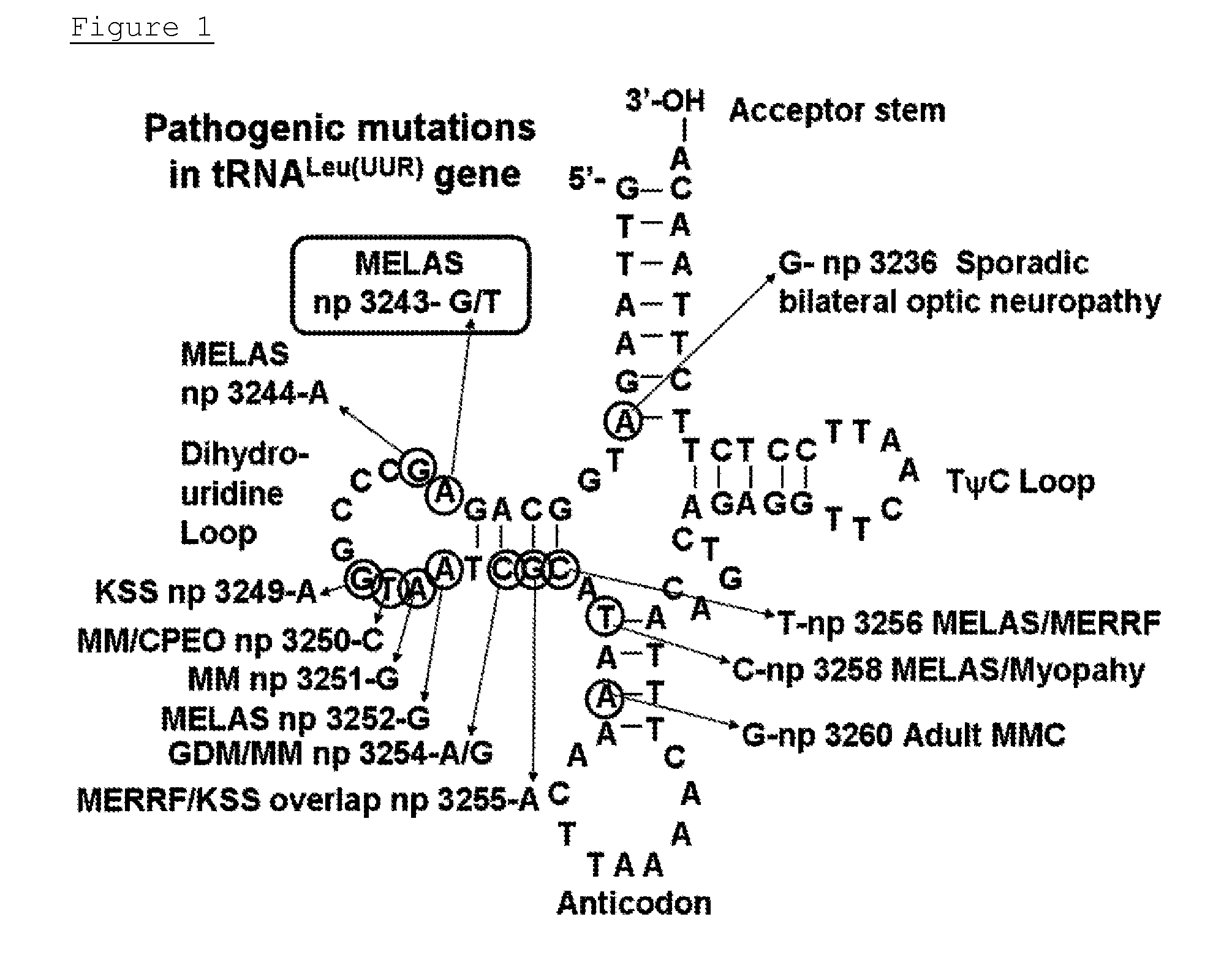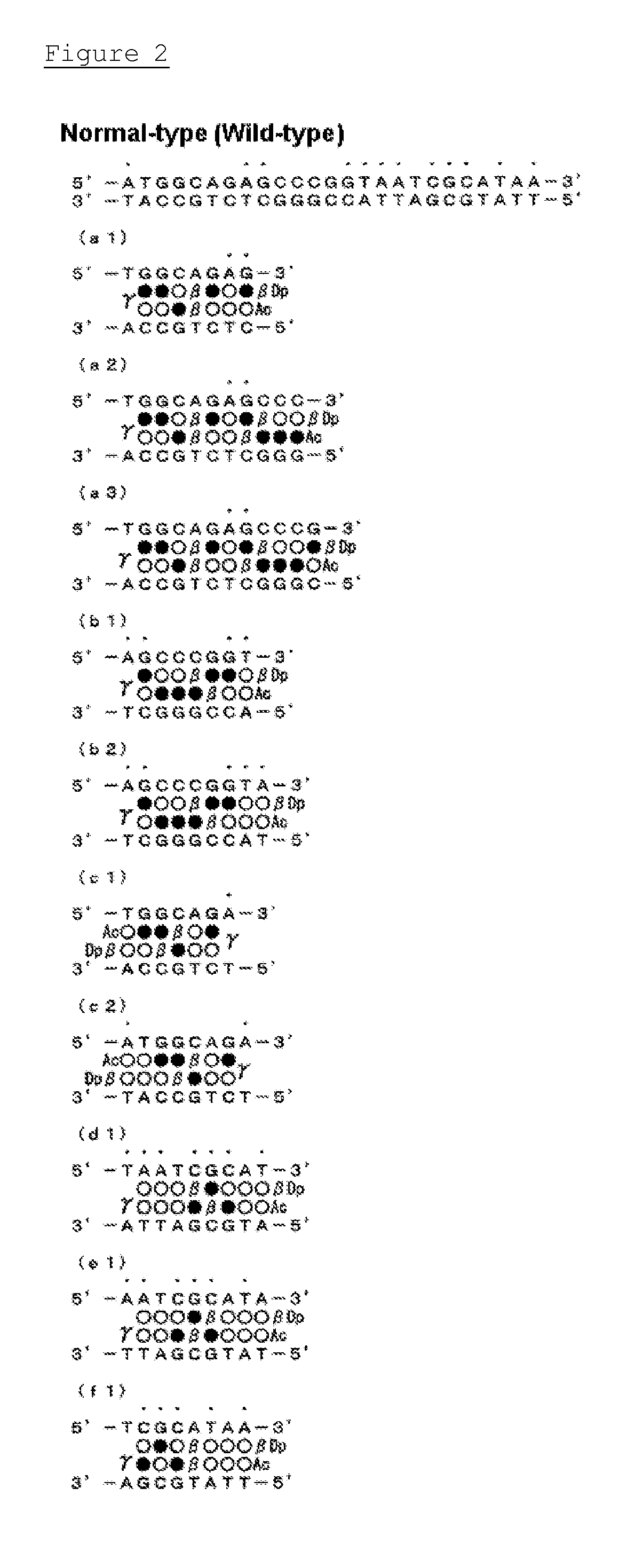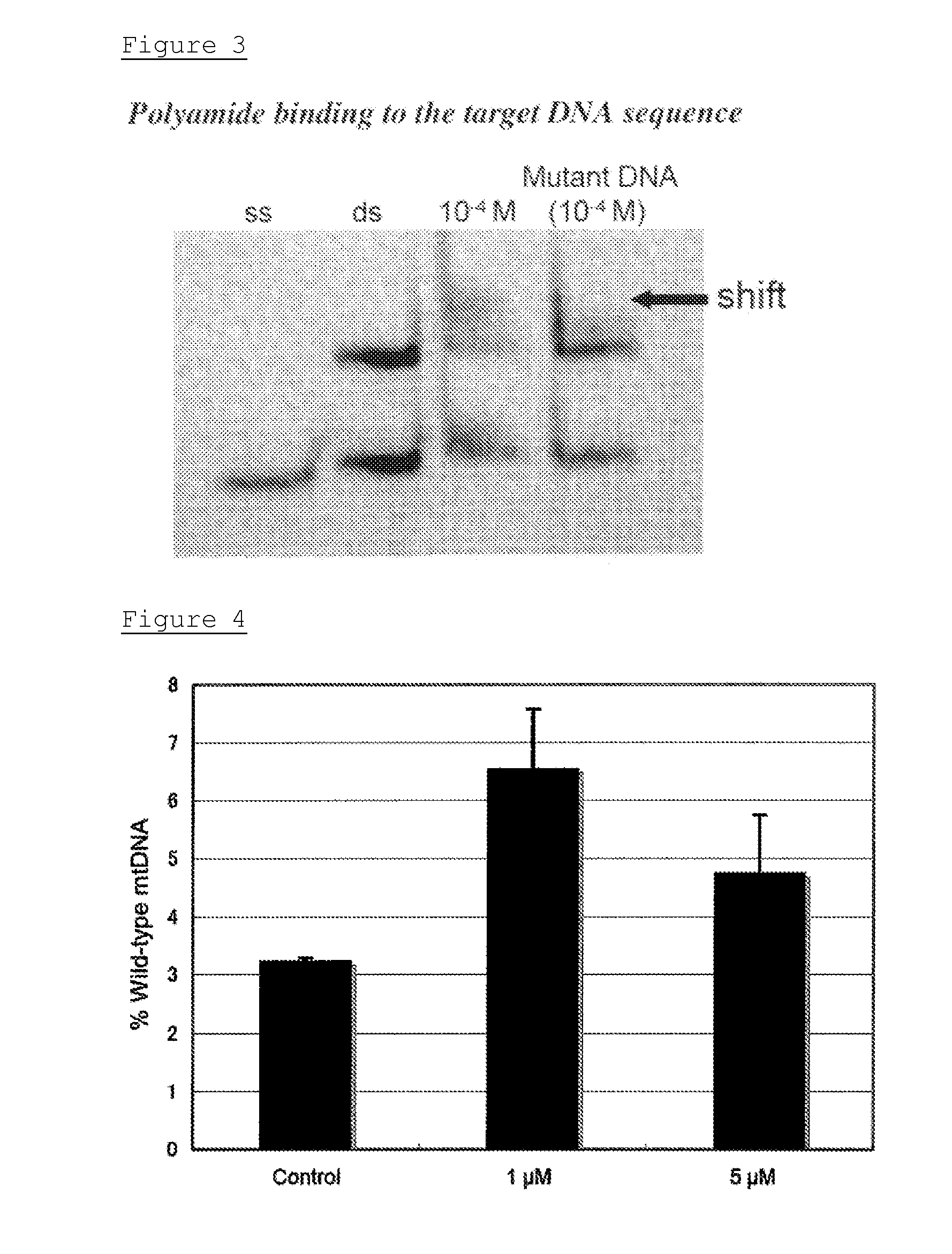Polyamide compound and pharmaceutical composition for treating mitochondrial genetic disease
a technology of mitochondrial genetic disease and polyamide compound, which is applied in the direction of drug composition, metabolic disorder, cardiovascular disorder, etc., can solve the problems of limited effect, failure to cure, failure to cure, etc., and achieve the effect of reducing energy production and reducing mutant mtdna
- Summary
- Abstract
- Description
- Claims
- Application Information
AI Technical Summary
Benefits of technology
Problems solved by technology
Method used
Image
Examples
example 1
[0160]In this Example, an ML1 polyamide was produced in accordance with an Fmoc method by a solid-phase synthesis. The ML1 polyamide has the follow sequence: Ac-Py-Py-Py-β-Im-Py-Py-γ-Im-Im-Py-β-Im-Py-Im-β-Dp.
[0161]In the synthesis, NovaPEG Wang Resin was used as a solid-phase, and Py(N-methylpyrrole), Im(N-methylimidazole), β-alanine, or γ-aminobutyric acid was sequentially added by dehydration condensation (amide binding), and a chain was extended. Finally, N,N-dimethyl-1,3-propanediamine was added, and the whole was removed from the solid-phase surface around 60° C. to obtain a polyamide compound. A molecular weight of the resulting polyamide compopund was confirmed by a mass spectroscope (Shimadzu Corporation).
[0162]The resulting ML1 polyamide was purified by elution from 0.1% acetate / acetonitrile gradient in reverse phase chromatography (Prominence / LC solution, Shimadzu Corporation). The resulting ML1 polyamide was lyophilized in a vacuum by FDU-1200 (Tokyo Rikakikai Co., Ltd.; ...
example 2
[0166]In this Example, a binding specific to the base sequence was confirmed in vitro between the ML1 polyamide and the target. The assay was carried out in EMSA (electrophoretic mobility shift assay). The wild-type oligo-DNA with 21 bases containing the 3243rd base on which the A3243G mutation exists and the A3243G mutation oligo-DNA thereof were produced. A sense-stranded DNA with FITC bound at 5′-end and an antisense-stranded DNA were thermally denatured, slowly cooled, and annealed to obtain dsDNAs having the following sequence:
5′-FITC-TGTTAAAGATGGCAGAGCCCG-3′ 3′-ACAATTTCTACCGTCTCGGGC-5′5′-FITC-TGTTAAAGATGGCAGGGCCCG-3′ 3′-ACAATTTCTACCGTCCCGGGC-5′
[0167]The underlined portions are recognition domains of the MLI polyamide.
[0168]To dsDNA (50 pmol / 10 μL), 40 μL of ddH2O was added and the whole was diluted to 1 pmol / μL. 4 pmol of the resulting dsDNA were mixed with the MLI polyamide solution so that the concentration became 10−4M, and incubated for 1 hour at 37° C. Then, the s...
example 3
[0172]In this Example, the effect of facilitating replication of wild-type mtDNAs by the MLI polyamide in cells was confirmed.
[0173]The MLI polyamide was given to the cultivated MELAS cybrid cells to confirm if the wild-type mtDNAs were positively reproduced in cells.
[0174]2SD cybrid cells were seeded on a 10 cm dish, and the MLI polyamide dissolved in 50% DMSO was added to the complete DMEM so that a final concentration thereof became 1 μM, 5 μM, or 10 μM. The medium to which the MLI polyamide was added was replaced every third day. In the control experiments, DMSO with the same diluted rate was added to the medium. The polyamide solution in 50% DMSO solution was diluted with ddH2O so that the concentration of DMSO in the medium became 0.1% or less, or 0.05% at a maximum.
[0175]Total DNAs were extracted from the cybrid cells treated by the MLI polyamide 14 days later, PCR-RFLP was then carried out, the bands were quantitatively analyzed by microchip electrophoresis (MCE-202 MultiNA;...
PUM
| Property | Measurement | Unit |
|---|---|---|
| energy production | aaaaa | aaaaa |
| chemical energy | aaaaa | aaaaa |
| electrophoresis | aaaaa | aaaaa |
Abstract
Description
Claims
Application Information
 Login to View More
Login to View More - R&D
- Intellectual Property
- Life Sciences
- Materials
- Tech Scout
- Unparalleled Data Quality
- Higher Quality Content
- 60% Fewer Hallucinations
Browse by: Latest US Patents, China's latest patents, Technical Efficacy Thesaurus, Application Domain, Technology Topic, Popular Technical Reports.
© 2025 PatSnap. All rights reserved.Legal|Privacy policy|Modern Slavery Act Transparency Statement|Sitemap|About US| Contact US: help@patsnap.com



